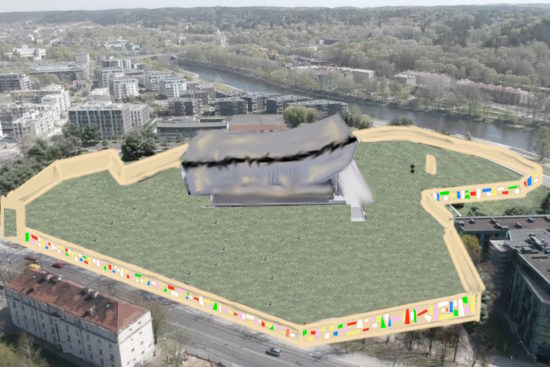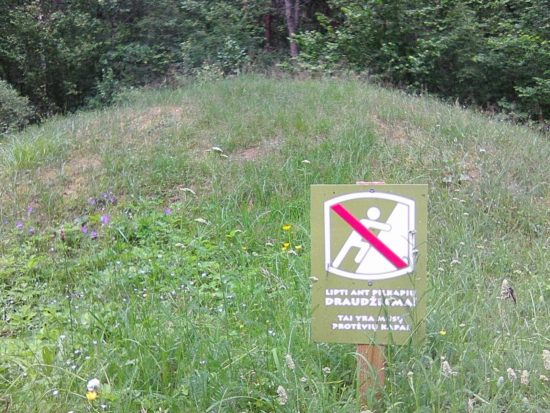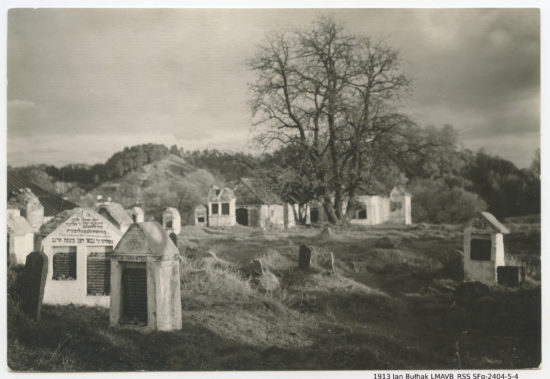OPINION | HUMAN RIGHTS | CHRISTIAN-JEWISH ISSUES | CEMETERIES & MASS GRAVES | OLD VILNA JEWISH CEMETERY AT PIRAMÓNT | OPPOSITION TO CONVENTION CENTER PROJECT | INTERNATIONAL PETITION
◊
by Andrius Kulikauskas
◊

Where the old Soviet Sports Palace stands within the old Cemetery Wall. A group of Lithuanians and Litvaks are working together to ensure that the wall’s historic path will be clearly marked for future generations of visitors to Vilnius.
“Gerbkime kapines” (Respect Cemeteries) at www.kapines.com is our small team of Lithuanians and Litvaks who are working together locally to defend the honor of the oldest Vilnius Jewish Cemetery, known variously as the Piramont or Šnipiškės Cemetery. The Soviets desecrated the site by building a Sports Palace there. The Republic of Lithuania and the City of Vilnius are moving ahead with their plans to open a convention center there in 2023.
Our team is now reaching out internationally with a variety of activities to join or support. We need writers, translators, researcher, web page creators and maintainers, and we also need donations.
◊
Our Mindset
We are very few and our challenge is very daunting. We are countering the resolute will of not only the state bureaucracy and local apparatus but also their loyal partner, the Lithuanian Jewish Community which is recognized as “the official organization representing the interest group”.
We are volunteers. We are doing what we can. We are not trying to “win”. We are not trying to argue our case. It is clear by now that the government will not listen to any arguments. Rather we have reason to believe that there are all manner of miracles by which G-d’s finger might change the course of history, as we have already witnessed, such as the granting of heritage status to the Sports Palace, the disclosure of corruption in the bidding process, and the coronavirus pandemic. Our priority is for us to learn to work as a happy, friendly, positive team which embraces, includes, attracts and inspires all manner of people.
We understand that there is every indication that the Lithuanian leadership will prevail. We know that healing cemeteries takes decades and centuries, and in our case, requires a national reaffirmation of a basic respect for all cemeteries, a respect that we lost during the Soviet era. Further desecration of the cemetery simply makes our efforts all that more meaningful to those who are hurt and who care. The Sports Palace lasted hardly forty years. How long would a Convention Center last? We thus are thinking of what activities are positive, healthy, friendly, nourishing, meaningful for us in the very long term.
It is our long term dedication that can make the biggest impression upon our opponents. The weak link in the government’s plan is that it needs to find an operator. Our regular activity can dissuade all of the reputable operators. Still, the government may find a less than reputable company that will sign a ten-year contract and do its best to make a profit. If we persist in our holy deeds, then surely that company will fail miserably, and no company will ever want to try. Then some new government will consider doing away with the Convention Center and recognizing the Cemetery. What is important is not this particular scenario, but the fact that our long term commitment, ten years and more, is what can make our current government think twice.
Envisaging our long term commitment means that we are taking things slowly, acting regularly, sparing our energy, accepting many short term disappointments, nurturing our relationships, maintaining moral standards, doing what is enjoyable and meaningful, staying positive. Of particular importance is bridging the Lithuanian and Litvak worldviews both locally and internationally.
◊
Monthly Events at the Cemetery
A vital part of our strategy is to organize monthly events at the Cemetery, on location, and to publicize those events in the Lithuanian press. The point is to brand the site as a Cemetery. We can think of each event and article as representing the loss of 100,000 euros to the potential operator. More importantly, meeting on location helps us understand what activities are most appropriate at the site so that it truly is taken to be a Cemetery.
Our member Ruta Bloshtein is the author of the petition which 51,457 people have signed imploring that the Lithuanian government move the planned Convention Center away from the Cemetery. Exactly five years ago she wrote her first article at Defending History on this issue. She wrote how she was inspired by the fast day, Tíshebov (Tisha B’Av), and the tradition of visiting the tombs of devoted rabbis. Clearly, we should make a tradition of visiting our Cemetery every year at this time. We decided to go on the Eve of Tíshebov because then people of all faiths can feel they are supportive without actually personally embracing the Jewish faith, but also because the fast day itself can be physically challenging, a day of weakness and headaches.
We thus invite all to join us on July 29, Wednesday, 17:00-20:00, at Rinktinės street near the intersection with A. Juozapavičiaus St. See the Facebook post for more details or contact Andrius Kulikauskas at ms@ms.lt or +370 607 27 665.
Other days that suggest themselves are the Fast of Gedalia, on the third day of the Jewish New Year, which will be September 21, 2020, and the death of the Gaon of Vilna on October 9 or perhaps the day of his burial. We have also met at the Cemetery on our national days of independence, February 16 and March 11, and our national tragedies of January 13 and June 14.
Please write to Andrius Kulikauskas at ms@ms.lt if you have a group coming to Vilnius that would like to organize an event together at the Cemetery.
◊
The Wall
In learning to respect all cemeteries, it becomes clear that a most vital function is played by the boundary, the fence, the wall. In 1831, in quelching the Lithuanian and Polish uprising, the Russian Czar built a fortress upon part of the Cemetery, and tore down the entire wall so that rebels could not use it for cover. In 1939, the Vilnius Jewish Community erected a concrete wall. Sadly, it was destroyed during the war.
The simple act of marking the boundary by chalk or string or stones is enough to make evident that the Cemetery is not some mystical location. It has an indelible boundary that makes it absolutely concrete. This is enough for reputable people to reorient themselves, and thus by degrees to change the nature of the place inexorably. As in the game of Go, to surround the Sports Palace with pebbles is to remove it from the board.
Thus on the Eve of Tíshebov we will walk around the cemetery and mark its boundary with stones. We hope that others come with more stones. Some 50,000 people signed Ruta Bloshtein’s petition, and similarly, 50,000 stones would completely delineate the boundary, which is almost one-kilometer long. Our activity will show that there is every reason to rebuild the Gate and the Wall, whether or not there is a Convention Center. Ultimately, the outside of the Wall may tell a thousand stories of how Lithuanians stood up for Litvaks, and how Litvaks lived in their faith. This is a joint project that can transform our relationships along with the location.
◊
Cartoon Contest
DefendingHistory.com has published a series of editorial cartoons that get to the heart of defending our Cemetery. Such visual thinking is essential for people to get interested and learn more.
Arkadij Kurliandchik is organizing our international cartoon contest, “No Rest, No Peace”. He has the help of world renowned Litvak animator Ilya Bereznickas. Edmundas Kulikauskas and Dov and Chaya Fried have donated 100 euros for 1st prize, 50 euros for 2nd prize and 35 euros for 3rd prize. We are currently asking for further donations so that these prizes might grow more significant and attract more participants. Cartoons are especially useful in that they can work with text and captions in any language. Please send donations to Andrius Kulikauskas by PayPal at ms@ms.lt
◊
Archival Material
Regina Kopilevich, Polina Pailis, Ruta Bloshtein and Edmundas Kulikauskas have been visiting Lithuania’s archives and museums to collect digital images of photos and documents relating the history of our Vilnius Jewish Cemetery. I will be uploading this material to our archives at www.kapines.com
If you can help with research, the collection of images and documents, or if you can help with translating materials between languages such as Hebrew, English and Lithuanian, or if you would like to contribute your computer skills in creating, organizing and maintaining web pages, then please write to Andrius Kulikauskas at ms@ms.lt
◊
Letter Writing
The Lithuanian government is resolved in its purpose to transform the Sports Palace into a Convention Center and it is convinced that the blessing of the Lithuanian Jewish Community gives it every moral right to do so. In the short term, it is futile to argue with it. However, in the longer perspective, it is very important to systematically engage all levels of the government, keep asking it questions and keep collecting its answers. This interaction reveals who might be sympathetic to our perspective and who are the selfish interests that are leading Lithuania in this travesty.
A coordinated effort could achieve results. Letters can be in English. They should be short, reasonably well informed, and consist of one or two specific questions. The respondents are then basically required to answer, and we can post their answers at www.kapines.com Generally, none of the answers will be too helpful as such, yet their overall pattern can be most revealing. Also, we can follow up with local visits and meetings, especially with those officials who might be supportive. Parliamentary elections are coming up on October 11, and it would be also be helpful to write letters to political parties and to candidates.
For example, Mindaugas Pakalnis, the Chief Architect of Vilnius, is set to give approval for construction at the site of the Sports Palace and the Cemetery’s “protective zone”. He returns from vacation on August 3 and his senior advisor on this matter, Rūta Matonienė, returns on August 10. He wrote to me that I write to her, and she told me about the pending approval. However, she referred many of my related questions to the Chancellory of the Lithuanian Government, saying that the architects are simply implementing the government’s decision Nr.597 of June 9, 2015, which established the reconstruction of the Vilnius Sports Palace as a project of national importance. I don’t have the spirit to write to the government, but rather, I could help others do that.
I also spoke with Darius Daunoras who leads the City Architect’s Subdivision for Protecting Cultural Heritage. I invited him to our event, but he declined, explaining that he did not want to be involved in Jewish politics. He affirmed his own opinion, which is that the Congress Center should proceed as planned. He claimed, as a historian, that the Jews had sold their cemetery plots to the Czar for a handsome price. This horrid tale, which is popular among Lithuania’s antisemites, defies the historical fact, as noted by historian Vytautas Jogėla, that in 1831 the Czar of Russia ordered a fort built in Vilnius to quell the Lithuanian-Polish rebellion of 1831. Thus the Russian army seized about one-fourth of the Cemetery, near the river Neris, and built their fort on it. Lithuanians, Poles, Jews were all victims of Russian imperialism. The only basis for the antisemitic tale that I can find is a single report by the Vilnius Police Chief which states that the Imperial Commission had stepped in to reduce the compensation from 4,500 rubles to 3,500 rubles. Of course, any such so-called compensation in no way legitimizes the Czar’s brutality nor diminishes the rights of Jews to their Cemetery. Volunteers writing thoughtful, pertinent letters to Darius Daunoras could establish his views and ultimately call to question why he is the official responsible for protecting Vilnius’s Jewish Cemetery. As he told me, there will always be some people who will never be satisfied, and he has many other cemeteries to worry about. Indeed, on August 3, 2019, he was quoted by Ignas Jačauskas of BNS regarding preparations for the burial of newly discovered remains of rebel leaders from 1863 at a 19th century chapel in Rasų Cemetery which had recently been restored. “The rebels will be buried, properly honored, and I imagine that this will be an additional center of attraction for Lithuanians, for Poles and for Belarusians.”
If you would like to participate in coordinated letter writing, then please write to Andrius Kulikauskas at ms@ms.lt
◊
Writing Articles
Every month were are writing at least one article for the Lithuanian press. In particular, I have been writing articles which have been popular at the nationalist portal www.alkas.lt. It’s a challenge and a breakthrough to express our concerns in a way that is understandable to a Lithuanian nationalist, patriotic point of view. My recent article included a photo of a sign next to an ancient Lithuanian burial mound explaining, “It is forbidden to climb on burial mounds. They are the graves of our ancestors.”
The Lithuanian press publishes many articles about Lithuanian Jewish history, which apparently fascinates Lithuanians who long for new perspectives on their country. If you would like to write an article in English on what your Lithuanian Jewish background means to you, and what the fate of the Vilnius Cemetery means to you, then we could try to find a volunteer translator and an interested news publisher. Please write to Andrius Kulikauskas at ms@ms.lt
◊
Weekly Zoom Meetings in Lithuanian
Arkadij Kurliandchik, Valdas Valiūnas, Edmundas Kulikauskas and Andrius Kulikauskas speak in Lithuanian every Thursday for 40 minutes to coordinate our strategy and activities. Similarly, an international group of volunteers could have regular meetings in English or other languages.

